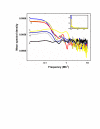Large-scale genomic correlations in Arabidopsis thaliana relate to chromosomal structure
- PMID: 15932642
- PMCID: PMC1166552
- DOI: 10.1186/1471-2164-6-82
Large-scale genomic correlations in Arabidopsis thaliana relate to chromosomal structure
Abstract
Background: The chromosomes of the plant Arabidopsis thaliana contain various genomic elements, distributed with appreciable spatial heterogeneity. Clustering of and/or correlations between these elements presumably should reflect underlying functional or structural factors. We studied the positional density fluctuations and correlations between genes, indels, single nucleotide polymorphisms (SNPs), retrotransposons, 180 bp tandem repeats, and conserved centromeric sequences (CCSs) in Arabidopsis in order to elucidate any patterns and possible responsible factors for their genomic distributions.
Results: The spatial distributions of all these elements obeyed a common pattern: the density profiles of each element within chromosomes exhibited low-frequency fluctuations indicative of regional clustering, and the individual density profiles tended to correlate with each other at large measurement scales. This pattern could be attributed to the influence of major chromosomal structures, such as centromeres. At smaller scales the correlations tended to weaken -- evidence that localized cis-interactions between the different elements had a comparatively minor, if any, influence on their placement.
Conclusion: The conventional notion that retrotransposon insertion sites are strongly influenced by cis-interactions was not supported by these observations. Moreover, we would propose that large-scale chromosomal structure has a dominant influence on the intrachromosomal distributions of genomic elements, and provides for an additional shared hierarchy of genomic organization within Arabidopsis.
Figures



References
MeSH terms
Substances
LinkOut - more resources
Full Text Sources

